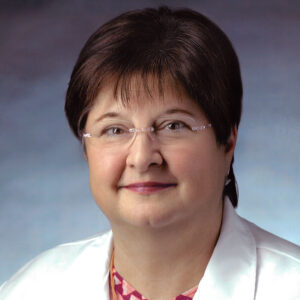By Santa J. Bartholomew M.D. FAAP, FCCM & Betsy Kastak, DNP, RN, C-PNP
See Corresponding Journal Article: Apnea
A 17-year-old boy with Down Syndrome presents for his annual office visit. He becomes quite agitated at visits, so his mother does not bring him in for visits often, in fact, it has been 5 years since he was seen but recently, he has had some back pain. His last visit was at age 11 ½ where he received his Tdap vaccine. No other diagnostics were done.
The patient is generally anxious and quiet playing with his handheld video game.
Current Review of Systems Per Mom:
In special education classes at school. Has a great appetite, willing to eat almost anything. He does not sleep well. He sleeps sitting up folded in half with his legs crossed and his head “practically in his lap”. She had “no idea” how much he sleeps. He is essentially nonverbal so he does not explain to her why he sleeps that way. But he points to his back and says, “ow” so she knows his back hurts.
On Exam:
- Characteristic craniofacial findings of a patient with Down Syndrome, small nose and small mouth and protruding tongue
- Height: 64 inches : 190 pounds.
- Spine pain on palpation around L2 or L3. Able to ambulate well. Good sensation
- Otherwise, normal exam.
On further discussion, Mom states that she does not believe he has ever had a sleep study. On further review of the patient’s health record since birth, it appears that he has never had any type of sleep study. Mom stated, “I think he sleeps ok, he just likes to sit up”.
The patient was immediately referred to a sleep overnight pulse oximetry where his oxygen was <80% saturation more than 75% of the time. He also had more than 300 episodes of apnea. He was referred to a tertiary care center for a formal overnight sleep study. It was recommended that he use a CPAP machine with 3 liters of oxygen. Fortunately, his cardiac echo was normal.
A year later, he came back to the primary care clinic for his visit. When asked about sleep, his mother expressed gratefulness that he had finally learned to tolerate his machine (it took months). When asked about his sleep position, she said, “Just on his back”.
Clearly this young man has had sleep apnea which is very common in children with Down Syndrome for a long time. The AAP recommends that a child have his/her first polysomnogram between 3 and 5 years of age if symptoms direct. This patient had never had one and his apnea had evolved to such a severe state, the only way he was able to keep his airway open was to sleep bent over with his head prone. Had this problem not been discovered, he might have developed severe cardiac issues secondary to this obstruction and ultimate death from right heart failure.





